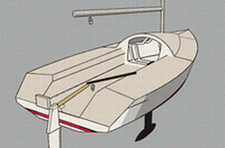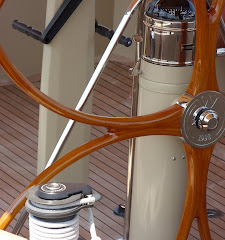We’ve had another busy week in the shop and have managed to get the frames installed, filets applied and taped in place. The first frame we installed was the forward most or frame “F” and then worked our way aft so that we would not have to crawl through the cabin frames as we went.
 We then put a 3” piece of plywood across the shear clamps. This helps hold the frames in place and takes out any bow that had set in while they were out of the hull during the glassing period. Then using the level we could line the sides plumb and screw them in place. This helped pull the sides of the hull back up tight to the frames. There are also small wood blocks on each side also screwed to the frame and the hull to hold those areas in place while filets are installed. It is important that the hull is lying level on its building lines or the frames will not be correct.
We then put a 3” piece of plywood across the shear clamps. This helps hold the frames in place and takes out any bow that had set in while they were out of the hull during the glassing period. Then using the level we could line the sides plumb and screw them in place. This helped pull the sides of the hull back up tight to the frames. There are also small wood blocks on each side also screwed to the frame and the hull to hold those areas in place while filets are installed. It is important that the hull is lying level on its building lines or the frames will not be correct.

 The mast step was installed between frames “D” and “E” with thickened epoxy (temporary screws to be removed). All surfaces will now get 2 coats of epoxy to seal the bare wood.
The mast step was installed between frames “D” and “E” with thickened epoxy (temporary screws to be removed). All surfaces will now get 2 coats of epoxy to seal the bare wood.
This whole procedure seemed to go quickly until I added up the hours. Stephanie was only available a short time during this step but when she mixed epoxy and I laid in the filets it went much faster.
Time:Setup and plumb frames (this was done one at a time but each took about the same amount of time) 1 hour 30 min
I found it easer to screw in some wood blocks laid on the lines we had drawn for each frame location and screw it in place from the back of each frame.  These screws are then removed after the filets are applied to the opposite side and the holes filled with thickened epoxy. Another issue when building on the frames as molds and then flipping the hulls is hull shape is hard to hold so when we began to install the frames we needed to pull the hull back into shape. Not only did it need to come together at the shear clamps but at frame “E” it also needed the upper chine pulled up. So the frame would fit under the shear clamps. Again using the block method solved this problem and once that frame was set the rest went easily.
These screws are then removed after the filets are applied to the opposite side and the holes filled with thickened epoxy. Another issue when building on the frames as molds and then flipping the hulls is hull shape is hard to hold so when we began to install the frames we needed to pull the hull back into shape. Not only did it need to come together at the shear clamps but at frame “E” it also needed the upper chine pulled up. So the frame would fit under the shear clamps. Again using the block method solved this problem and once that frame was set the rest went easily.
 These screws are then removed after the filets are applied to the opposite side and the holes filled with thickened epoxy. Another issue when building on the frames as molds and then flipping the hulls is hull shape is hard to hold so when we began to install the frames we needed to pull the hull back into shape. Not only did it need to come together at the shear clamps but at frame “E” it also needed the upper chine pulled up. So the frame would fit under the shear clamps. Again using the block method solved this problem and once that frame was set the rest went easily.
These screws are then removed after the filets are applied to the opposite side and the holes filled with thickened epoxy. Another issue when building on the frames as molds and then flipping the hulls is hull shape is hard to hold so when we began to install the frames we needed to pull the hull back into shape. Not only did it need to come together at the shear clamps but at frame “E” it also needed the upper chine pulled up. So the frame would fit under the shear clamps. Again using the block method solved this problem and once that frame was set the rest went easily. We then put a 3” piece of plywood across the shear clamps. This helps hold the frames in place and takes out any bow that had set in while they were out of the hull during the glassing period. Then using the level we could line the sides plumb and screw them in place. This helped pull the sides of the hull back up tight to the frames. There are also small wood blocks on each side also screwed to the frame and the hull to hold those areas in place while filets are installed. It is important that the hull is lying level on its building lines or the frames will not be correct.
We then put a 3” piece of plywood across the shear clamps. This helps hold the frames in place and takes out any bow that had set in while they were out of the hull during the glassing period. Then using the level we could line the sides plumb and screw them in place. This helped pull the sides of the hull back up tight to the frames. There are also small wood blocks on each side also screwed to the frame and the hull to hold those areas in place while filets are installed. It is important that the hull is lying level on its building lines or the frames will not be correct. Next up is applying the filets. These are simple thickened epoxy welds that fill any gaps and make a rounded transition for the tape to lie in. They are also considered a structural element. We use wood flour to thicken the epoxy for these. Using small batches of epoxy, about 3-4 oz, we add enough of the wood flour to get a consistency of peanut butter. The easiest method of getting this mixture in place is similar to a pastry bag, we use disposable bags instead of real pastry bags.

After the mixture is applied use a tongue depressor to smooth the filet. We cut one end off these so that it also serves as a scrapper to remove the excess filler as you go. The filets were left to cure overnight before removing the screws from the block and the other side then filled. After letting the second side cure for about 2-3 hours I could begin lying in the bi-axel tape to finish the seams.
 The mast step was installed between frames “D” and “E” with thickened epoxy (temporary screws to be removed). All surfaces will now get 2 coats of epoxy to seal the bare wood.
The mast step was installed between frames “D” and “E” with thickened epoxy (temporary screws to be removed). All surfaces will now get 2 coats of epoxy to seal the bare wood.This whole procedure seemed to go quickly until I added up the hours. Stephanie was only available a short time during this step but when she mixed epoxy and I laid in the filets it went much faster.
Time:Setup and plumb frames (this was done one at a time but each took about the same amount of time) 1 hour 30 min
Filet first side of frames 1 hour 30 min
Filet second side of frames 1 hour 30 min
Lay in bi-axel tape 4 hours
Total this segment: 8 hours 30 min
Total Project Hours To Date: 84 ½ hours



 I felt a bit of déjà vu as I began to work on the female molds in preparation of turning the hull this weekend. The molds will act as wheels with the boat as the hub and allow the whole thing to be turned quite easily. I laid out lines on frames “A” and “D” so that I could make the molds to hold the boat during turning and as a cradle afterwards. I wanted to be able to work around the molds so the “D” mold was made to come apart just above the lower chine after turning. These were both made from ½” OSB or chipboard as some people call it. I doubled the edges where necessary and rounded the corners to roll easily when the time came.
I felt a bit of déjà vu as I began to work on the female molds in preparation of turning the hull this weekend. The molds will act as wheels with the boat as the hub and allow the whole thing to be turned quite easily. I laid out lines on frames “A” and “D” so that I could make the molds to hold the boat during turning and as a cradle afterwards. I wanted to be able to work around the molds so the “D” mold was made to come apart just above the lower chine after turning. These were both made from ½” OSB or chipboard as some people call it. I doubled the edges where necessary and rounded the corners to roll easily when the time came.









